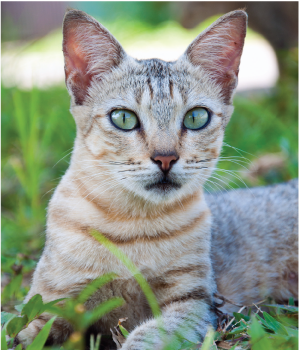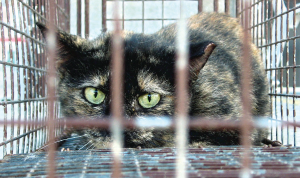
Did you know?
- Most of the cats that we see in our neighborhoods are thriving, healthy animals.
- Only 3% of all cats that are impounded at the Animal Service Center are reclaimed by an owner.
- Trap, Neuter, and Return (TNR) is the most widely accepted humane method for stabilizing and reducing free-roaming cat populations.
- Florida Statute 828.12 prohibits acts of cruelty toward cats.
Cats in Our Community
Community cats are unowned free-roaming cats, including both feral (wild) and socialized cats that mingle in neighborhoods, commercial parking lots, and other locations where resources are available to them. Like all animals, community cats make their homes where they find shelter and food, often near humans. They often live in groups called colonies and have strong social bonds with their colony members.
Does Trap & Remove Work?
The historical practice of trap and remove does not work and resulted in thousands of unowned cats being euthanized at the Animal Service Center due to not being reclaimed or adopted. This practice was ineffective in reducing the population of unowned, free-roaming cats. As cats are removed from the location, new cats move in to take advantage of the existing food and shelter resources; this is a documented phenomenon in a variety of animals throughout the world and is referred to as the vacuum effect.
Simple Solutions to Deter Cats
- Do not feed stray cats.
- If you are feeding cats, put down only the amount the cats will eat in one sitting and remove the remaining food after 30 minutes. Keep the feeding area clean and free of trash; leftover food attracts additional cats and wildlife.
- Talk to your neighbors. Determine whether the cat is a pet, stray, or feral and if it has been spayed or neutered. If not, get it done.
- Yowling, fighting, and spraying are mating behaviors displayed by cats that have not been spayed or neutered. Spaying and neutering the cats will stop these behaviors usually within 3 weeks.
- Spaying and nuetering will also stop unwanted litters of kittens.
- To remove cat urine odors, spray area thoroughly with white vinegar, or with other products that use natural enzymes to combat the smell.
- Apply nontoxic deterrents around your yard, such as coffee grounds, vinegar, pipe tobacco or oil of lavender, citronella, or eucalyptus.
- Put a tight lid on your trash can to deter cats from getting into the trash.
- Prevent cats from getting under your home or deck by blocking openings with chicken wire or lattice.
- Use a car cover to prevent damage to your car.
- Install a motion-activated sprinkler that uses sensors to detect motion and scare unwanted animals away with sound and a startling, but harmless, burst of water.
- Spread commercially available animal repellants than contain non-toxic ingredients that repel by taste and odor.
If you Feed it, Fix it!

It is common for well-intentioned people to feed community cats. Feeding must be done responsibly as it creates an artificial food source that can lead to an increase in the population of free-roaming cats. Those feeding cats must have them altered and vaccinated otherwise they are contributing to the problem. In some jurisdictions to include the City the Tallahassee, feeding without ensuring the cats are spayed or neutered and vaccinated against rabies is unlawful.
Getting a Trap
Should it be your desire to trap, neuter, and return cats on your property, the Animal Service Center has loaner traps that can be borrowed. There is no rental fee; however, a $75 refundable deposit is collected to ensure the trap is returned. Additionally, traps can be purchased inexpensively at local hardware stores.
Assistance with spay or neuter may be available through local non-profits such as Be The Solution (BTS) and It’s Meow or Never (IMON).
Trap-Neuter-Return
Trap, Neuter, and Return (TNR) is the alternative to trap, remove, and euthanize and is nationally recognized as the best practice for an effective and humane way to help stabilize community cat populations. Cats are humanely trapped and taken to a veterinarian, where they are neutered, ear tipped, and vaccinated. Kittens and cats that are socialized to humans may also be placed for adoption while healthy community cats are returned to their original location which is where they live. Their lives and health are improved, there are no more kittens, and the population stabilizes and declines over time. The behaviors and stresses associated with mating, such as yowling and fighting, stop. There is reduced odor from cat urine and maintained rodent control.
Ear tipping is the universal sign of a neutered and vaccinated community cat. The procedure involves removing approximately a quarter-inch off the tip of the cat’s left ear in a straight line cut. This is done while the cat is anesthetized.
Tallahassee Animal Services supports the practice of TNR. Cats impounded without a rabies tag or traceable microchip that are determined to be at least three months of age may be returned to the location where they came from.
Version: 3399 (7/8/2019 12:56 PM) |